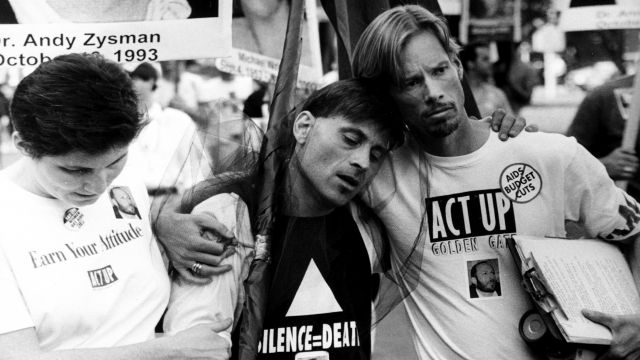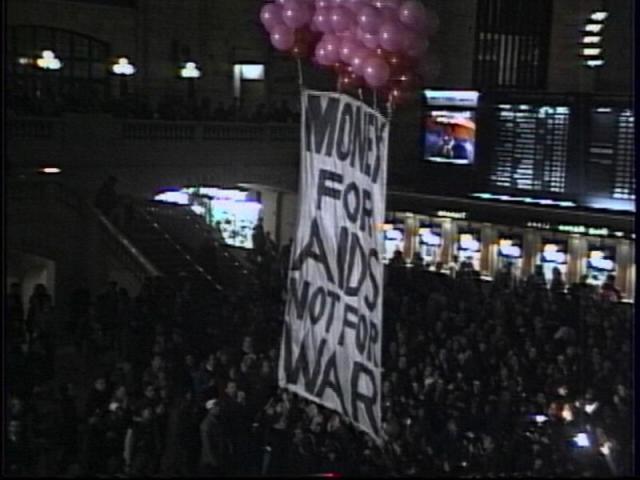
The ACT UP Oral History Project is an expansive work that rigorously details the history of ACT UP (AIDS Coalition To Unleash Power) New York. Frustrated by mainstream media's misrepresentation of the history of AIDS and AIDS activism, and the underrepresentation of ACT UP actions within this discourse, filmmaker Jim Hubbard and author/playwright Sarah Schulman decided to document testimonies from a diverse range of ACT UP participants and members. The project's website now contains more than 100 interviews with full transcripts. Through this wealth of first-hand accounts, Hubbard and Schulman delineate how thousands of people in ACT UP and its affinity groups fundamentally altered the course of the health crisis.
Hubbard then used this material to direct a full-length documentary entitled United in Anger: A History of ACT UP. With interviews and archival footage, the film shows how a group of people abandoned by the government, defiled in the media, and neglected by the medical establishment seized power via many calculated actions in order to demand rights and justice for people living with HIV/AIDS. United in Anger isn't just a historical snapshot of a particular activist moment, but an illustrative how-to of how profound social change happens.
This Thursday, as part of Concordia University's Community Lecture Series on HIV/AIDS, Hubbard will present and screen United in Anger. A Q&A session will follow the screening. NIGHTLIFE.CA spoke with Hubbard about the ACT UP Oral History Project and the film.
Nightlife.ca: The ACT UP Oral History Project is an immense and amazing work. The video clips online are so evocative. In all of the research you've done, are there stories that still surprise you?
Jim Hubbard: The interviewees continue to surprise and astonish us. Even though we knew all the people we've interviewed at least to some extent, we could never know everything they did in ACT UP. The key to ACT UP's success was the simultaneity of action. There were always lots of people doing lots of different things. In any given week, there might be 3 zaps and a local demonstration, plus planning for a national or international action, and always research on and disseminating vital, life-saving information.
Something else that stands out in the interviews is a pronounced sense of humour and frequent references to the cruisy/flirty nature of ACT UP meetings. Do these elements carry over into the film within all the imperative rage?
Whenever I watch the film with an audience, I hold my breath until early in the film when Gregg Bordowitz off-handedly mentions that there was always cruising going on in the meetings. If the audience laughs, I know they are really with the film and I can relax. It was extremely important to me to convey the whole range of emotions and activities that took place in ACT UP. That's why there are sections on AIDS activist video, Gran Fury, the affinity groups, civil disobedience and sex, and why we keep going back to the floor of ACT UP to show the meetings, in addition to examining as many of the demonstrations as possible. That complexity is crucial and fascinating. This is not a standard American five-character documentary. Using that formula would have completely misrepresented ACT UP. It's important to remember that many people within ACT UP rose to the occasion and took leadership positions and everyone contributed and many people have subtle analyses of what transpired.

ACT UP protesters use faux tombstones to represent the real causes of death for People with AIDS.
This work really illustrates that the history of ACT UP doesn't consist of a singular narrative. Can you talk about your process of making all of these interviews and this archival footage coalesce into United in Anger?
The first challenge of course was to whittle all that material down to an hour and a half. The AIDS Activist Video Collection of the New York Public Library consists of over 1,000 hours of archival footage. Over a two-year period, I looked at every single one of those tapes, even though I was familiar with the material. Eventually, I had a rough cut of approximately 3 hours. It consisted almost entirely of archival footage. I always knew that I would have to bring on an editor to complete the film. I have been immersed in this subject for 25 years and for the film to be understandable to people who did not live through the crisis, it needed someone with that perspective to do the final shaping. I was incredibly lucky to find Ali Cotterill, a young editor who did an amazing job shaping the film, adding the perfect interview excerpts that explained, deepened and expanded on the archival footage. Together we created not only a narrative arc, but also an emotional arc that conveyed a history of ACT UP. It is the history of ACT UP from ACT UP's point of view, though, of course, it is my version of ACT UP's point of view.

A giant banner reads “Money for AIDS not for War.” Released during a mass occupation at New York City's Grand Central Station.
United in Anger: The ACT UP Revolution On Screen
Concordia University Community Lecture Series on HIV/AIDS
Film screening + Q&A with director Jim Hubbard
Thursday, November 22 at 7 PM
Concordia University | 1455 de Maisonneuve W., Room H 110
actuporalhistory.org | aids.concordia.ca